I hardy hello to all my readers out there! It’s a new month and time to get going on my posts wouldn’t ya say? I was planning to get some pre-work done on a future post today while at our dog’s Agility Trial. Unfortunately, that didn’t happen because I ended up taking pictures all day instead. The good news is I already had another bird set ready to go. Actually multiple water fowl earned the post spot today. I’m going to start with one that apparently got the short straw when it came to appearance draws. I’m talking about the American White Pelican.
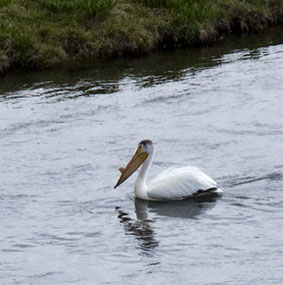
I spotted this one contently paddling along a small river while on our Yellowstone trip. The growth on his beak signifies this is a breeding male. Luckily the chicks apparently dig this blemish and is used in their courtship (no, I don’t want to know how) as well as ritualized combat. While looking through the lens at this guy, all I could think of was one of my favorite scenes from Uncle Buck when John Candy (rest in peace) lit into the grade school teacher because his niece was characterized as a sillyheart. Maybe he meant a MUSKRAT (dundun dun dun… blog teaser…).
I was actually disappointed I did not get to see him fish. At a later time on that trip, I came upon a couple of them out in a marshy lake.
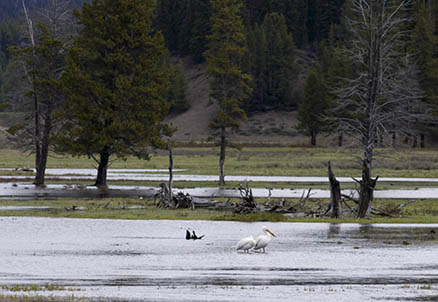
Apparently this is their preferred setting. It is actually a pretty nice picture with the deep color in the trees contrasted against the bright white of the pelicans. I had to shrink it down significantly which resulted in losing some of its visual. Let me bring it in a little for you.
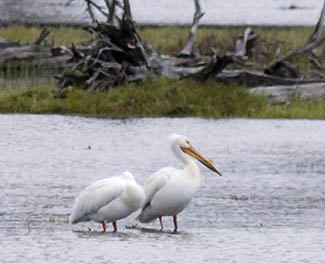
As you can tell (even with the zoom fuzz residuals) that it is another breeding male with likely his trophy wife. Once again I was unable to witness any fishing activity which sounds pretty interesting. In one of the descriptions in the bird guide, they described the technique. They work in groups to herd prey into shallow water or they ease into a school of feeding fish gulping ones that stray close to the surface. This description did not align with the settings I took these shots based on the most I found together was TWO.
Hit the jump to see two more birds being featured today, the Goldeneye and the Canadian Goose
Were not done yet! I am going to double the pleasure today and introduce you to another water fowl we saw while visiting Yellowstone. I am going to start with the distant picture because the closeups are not very good. These had to be pulled in from the very extents of the glass and since I did not take the time to pod the camera, I got what I deserved. There is just something very calming about watching a duck paddling around in a picturesque setting. They know the good life, no hurrying to meetings, no late night calls to Singapore to get an understanding of system process flows and certainly no mandates to get their TPS sheets in on time.
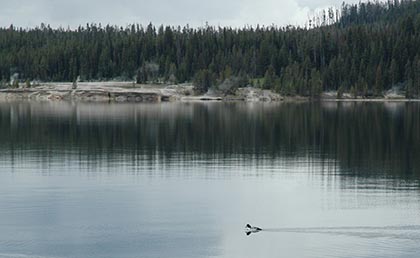
Sure, they have their threats (alligators, eagles, Loch Ness), but it doesn’t appear to stress this guy out at all. Note, the females have a pale brown head. I have some other shots that I brought in a little closer. Again, no tack sharp shots in this bunch and now a constant reminder to get the pods out if it has blog potential.
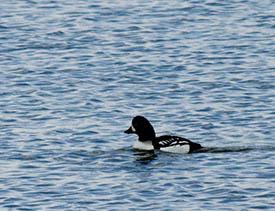
In contrast to the pelican, this species is actually pretty cool looking. Although, to the pelican’s credit, none of the goldeneye sightings were other than solitaire paddlers. I also never saw it doing any feeding which according to the guides is a diving technique.
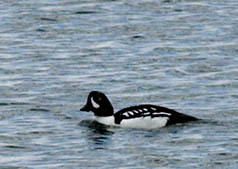
This sighting gives a better look at the vertical white strip near the bill. This signifies a breeding male. The immature males are not nearly as colorful (doesn’t seem to have any of the white striping).
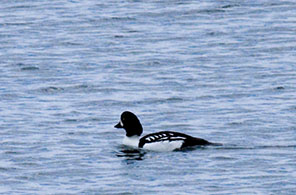
Interesting enough, there are two distinct breeds for the Goldeneye. One is found in the Rocky Mountain region (where these shots were taken) and another one calls Quebec home. Of course, the book failed to inform me what the difference is in these two groups so now there is an empty feeling in my knowledge gut.
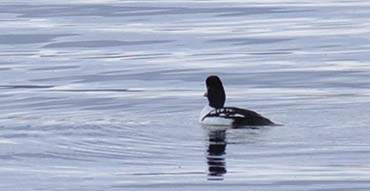
I’ll throw this shot in just to show another water texture. It is quite amazing the differences in one water setting from another ranging from the actual hues in the water to the textures brought on by the wind or wildlife movement. While traversing the photo collection for the wildlife pictures, I also set aside a number of just water settings that caught my eye. Sometime in the future they’ll make their appearance here.
…. and lastly, it’s time to give the Canadian Goose some screen time. These are pretty common around here and it is likely a common sighting in your neck of the woods. They are among the larger birds gracing the skies these days. According to the Sibley Guide, there are two main species in the North American region – The Lesser and The Richardson’s. I have to punt on this one boys, because I cannot tell the difference from just the visuals in the guide. Even the Rocky Mountain region Audobon guide doesn’t distinguish between the two. If there is one thing this I do know (and I think my brother can confirm) these birds are AGGRESSIVE when it comes to protecting their nests. If you get to close you will feel the wraith (bill pecking) from one very large and angry bird. “I have a beak and I’m not afraid to use it!” But before you get the wrong impression, take a look at this and just try to keep the smile off your face.

Mom and Dad out for a paddle with the offspring, teaching them the wise ways of the blue velvet. You can even get a sense of how proud the parents are from the way they hold their heads. Someday those little ones will leave the nest, brave the wild on their own and and look for mates to pass on the honks of life. May you teach them well Mom and Dad, may you make them wise.
Quick funny story, I was out golfing one later afternoon with my wife when some geese decided to walk across the fairway right in front of the green my wife was shooting at. She was probably 75 yards are so away and asked me what she should do about the birds in the way. After careful thought including an assessment of her day so far I told her to aim at them and don’t worry about it. This was based on her not having a lot of luck hitting it where she was aiming so I figured this was the safest advice for the safety of the geese. This turned out to be horribly WRONG. She ended up making probably the best shot of the day – good contact, good direction but must have closed up the club head since it screamed through the air about 2 feet off the ground. Sure enough, one of the geese took a shot to the tail feathers. To this day I am not sure who was more stunned, the bird, Linda (who immediately felt horrible for the bird) or me having just witnessed a one in a million shot. Of course, now I remind her of this every time we go golfing so I can get into her head – she tends to rub it in if she ties me on a hole and this takes some of the pressure off 8^)
So long for now everyone, have a great day!

